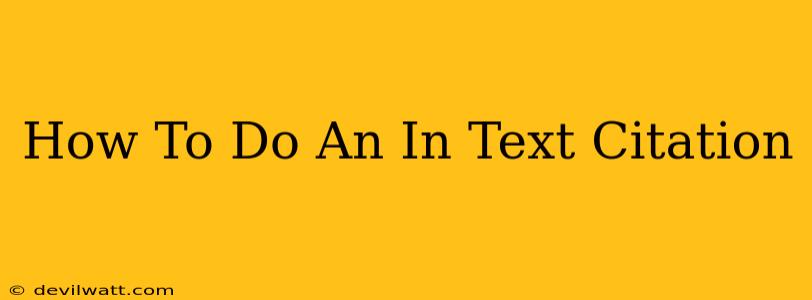Creating a well-researched paper involves more than just writing compelling content; it requires meticulous attention to detail, especially when it comes to properly citing your sources. In-text citations, those brief references within your text, are crucial for acknowledging the work of others and avoiding plagiarism. This guide will walk you through the intricacies of in-text citations, covering different citation styles and offering practical examples.
Understanding In-Text Citations
In-text citations are concise references placed within the body of your paper, directly following the information you've borrowed. They provide the reader with a quick way to locate the full source information in your bibliography or works cited page. The primary purpose is to give credit where credit is due and to allow readers to easily verify your information. Failure to properly cite sources can lead to academic penalties, including failing grades or even accusations of plagiarism.
Major Citation Styles: APA, MLA, Chicago
Several citation styles exist, each with its own specific rules. The most common are:
APA (American Psychological Association)
The APA style is widely used in the social sciences, education, and psychology. It generally uses the author-date system.
Example:
- Paraphrase: Research suggests that social media usage significantly impacts adolescent mental health (Smith, 2023).
- Direct Quote: Smith (2023) stated that, "Excessive social media use is correlated with increased anxiety and depression among teenagers." (p. 15).
Key Features of APA In-Text Citations:
- Author's last name and year of publication are usually included.
- Page numbers are required for direct quotes.
- Multiple authors are listed with an ampersand (&) before the last author (e.g., Smith & Jones, 2023).
- For more than two authors, use the first author's last name followed by "et al." (e.g., Smith et al., 2023) after the first citation.
MLA (Modern Language Association)
MLA style is predominantly used in the humanities, such as literature, languages, and cultural studies. It typically uses the author-page number system.
Example:
- Paraphrase: Social media's influence on adolescent mental well-being is a significant concern (Smith 15).
- Direct Quote: Smith argues that "the constant connectivity fostered by social media can lead to feelings of inadequacy and social comparison" (15).
Key Features of MLA In-Text Citations:
- Author's last name and page number are included in parentheses.
- Page numbers are required for both paraphrases and direct quotes.
- The period is placed after the closing parenthesis.
Chicago/Turabian
The Chicago/Turabian style is used across various disciplines, offering both a notes-bibliography and author-date system. The notes-bibliography system uses footnotes or endnotes for citations.
Example (Author-Date System):
- Paraphrase: The impact of social media on teenagers' mental health is substantial (Smith 2023).
- Direct Quote: Smith (2023, 15) argues that "the pervasive nature of social media contributes to anxiety."
Example (Notes-Bibliography System):
- Footnote: 1. John Smith, Social Media and Adolescent Wellbeing (New York: Publisher, 2023), 15.
Key Features of Chicago/Turabian In-Text Citations:
- The author-date system closely mirrors APA style.
- The notes-bibliography system uses numbered footnotes or endnotes for detailed citations.
Handling Different Source Types
In-text citation methods vary slightly depending on the type of source. For example, citing a website differs from citing a book or journal article. It's crucial to consult your chosen style guide for specific instructions regarding various source types. Remember to always include the necessary information to help your reader easily locate the full citation in your bibliography.
Common Mistakes to Avoid
- Missing Citations: This is a serious offense and constitutes plagiarism. Always cite your sources.
- Incorrect Formatting: Adhering strictly to your chosen style guide's formatting rules is crucial.
- Inconsistent Citation Style: Maintain consistency throughout your paper.
Mastering In-Text Citations: A Continuous Process
Properly citing sources is a vital skill for academic success. While initially challenging, mastering in-text citations will improve your writing and uphold academic integrity. Familiarize yourself with the specific rules of your chosen style guide and don't hesitate to seek assistance if needed. By diligently following these guidelines, you can effectively integrate citations into your work and confidently present your research.

